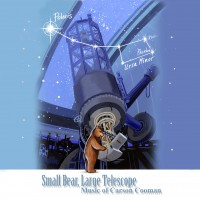Opus 685
Shining Space: Quintet for Horn and Strings (2006)
for Horn and String Quartet
- Bright Morning Sky
- I Am the Vine
- Chasing Windflower
Konstantin Sokol, horn and the Ukrainian Quartet
Duration: 17 min.
Dedication: for Hazel Dean Davis and Stephen Hackbarth, in celebration of their marriage, June 24, 2006
Commission: Commissioned by Hazel Dean Davis and Stephen Hackbarth
 Recorded on Small Bear, Large Telescope: Music of Carson Cooman (2006)
Recorded on Small Bear, Large Telescope: Music of Carson Cooman (2006)Publisher: Musik Fabrik
Performance materials available from the publisher.
Shining Space: Quintet for Horn and Strings (2006) was commissioned by and is dedicated to Hazel Dean Davis and Stephen Hackbarth on the occasion of their marriage, June 24, 2006. The work was premiered by James Sommerville, horn with Sarah Kapustin and Francesca Anderegg, violins, Nathan Burke, viola, and Peter Lorenzo Anderegg, cello.
The basic musical material for the work is a set of intervals which is gradually “expanded outward”—moving from close dissonance to luminous consonance. This could be seen to represent a sense of freedom, growth, and a bright future.
The first movement, Bright Morning Sky, begins vibrantly with ecstatic ringing in the higher strings. The cello presents the work’s basic pitch material in dramatic gestures. The horn then enters: first abortively and then affirmatively—changing the texture to focus on itself. The horn continues lyrical melodic development while the strings react, dissipating their initial energy. Nervous tremolos in the strings start to build back energy again, leading to a wild climax. The music then relaxes into the next section marked “Slow, suspended.” The horn and strings interact melodically, supported by luminous harmonies. The nervous tremolos return, regaining energy towards the coda. The work ends with the ecstatic ringing of the opening—but, this time, the harmonic material is open and bright.
The second movement, I Am the Vine, is serene and expressive—consisting of a series of canons which develop, break-off, and start again. The canons are almost always in two voices—representing two lives intertwining.
The third movement, Chasing Windflower, returns to the energy of the opening movement. However, the harmonic language begins this time with the open sonorities. Darker colors (from the first movement) continue to interject, but are always overwhelmed by a sense of free-wheeling excitement. The work presses on to an ecstatic coda—with a sense of unfettered joy.
